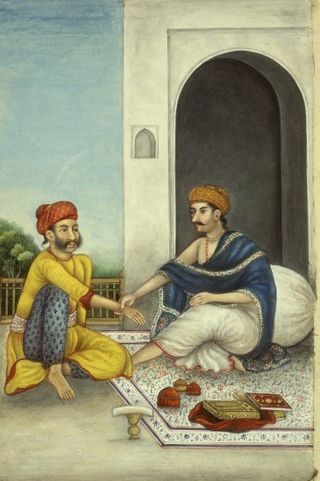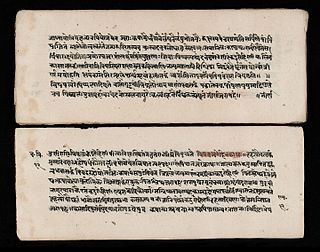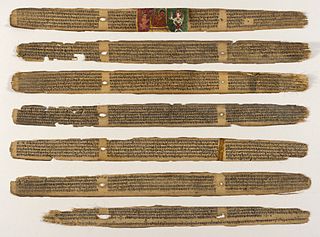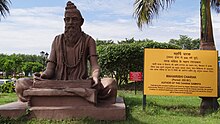
Ayurveda is an alternative medicine system with historical roots in the Indian subcontinent. It is heavily practiced in India and Nepal, where around 80% of the population report using ayurveda. The theory and practice of ayurveda is pseudoscientific.
Vāgbhaṭa (वाग्भट) was one of the most influential writers of Ayurveda. Several works are associated with his name as author, principally the Ashtāṅgasaṅgraha (अष्टाङ्गसंग्रह) and the Ashtāngahridayasaṃhitā (अष्टाङ्गहृदयसंहिता). The best current research, however, argues in detail that these two works cannot be the product of a single author. Indeed, the whole question of the relationship of these two works, and their authorship, is very difficult and still far from solution. Both works make frequent reference to the earlier classical works, the Charaka Samhita and the Sushruta Samhita. Vāgbhaṭa is said, in the closing verses of the Ashtāṅgasaṅgraha to have been the son of Simhagupta and pupil of Avalokita. His works mention worship of cattle and Brahmanas and various Hindu gods and goddesses, he also begins with a note on how Ayurveda evolved from Brahma and Sarasvati. His work contains syncretic elements.

Dosha is a central term in ayurveda originating from Sanskrit, which can be translated as "that which can cause problems", and which refers to three categories or types of substances that are believed to be present conceptually in a person's body and mind. These Dosha are assigned specific qualities and functions. These qualities and functions are affected by external and internal stimuli received by the body. Beginning with twentieth-century ayurvedic literature, the "three-dosha theory" has described how the quantities and qualities of three fundamental types of substances called wind, bile, and phlegm fluctuate in the body according to the seasons, time of day, process of digestion, and several other factors and thereby determine changing conditions of growth, aging, health, and disease.

Pulse diagnosis is a diagnostic technique used in Ayurveda, traditional Chinese medicine, traditional Mongolian medicine, Siddha medicine, traditional Tibetan medicine, and Unani. Although it once showed many positive results, it no longer has scientific legitimacy, but research continues and is ill-defined in some derived text, and is subjective.
Agnivesha is a legendary rishi (sage) in Hinduism, reputedly one of the earliest authors on Ayurveda. He is described to have codified the knowledge of his preceptor, Atreya, and arranged it in the form of a treatise, named the Charaka Samhita.
Agni in Samskrita means "fire", and according to Ayurveda, Agni happens to be the entity that is responsible for all digestive and metabolic processes in the human beings.

The Charaka Samhita is a Sanskrit text on Ayurveda. Along with the Sushruta Samhita, it is one of the two foundational texts of this field that have survived from ancient India. It is one of the three works that constitute the Brhat Trayi.

The Sushruta Samhita is an ancient Sanskrit text on medicine and surgery, and one of the most important such treatises on this subject to survive from the ancient world. The Compendium of Suśruta is one of the foundational texts of Ayurveda, alongside the Charaka-Saṃhitā, the Bhela-Saṃhitā, and the medical portions of the Bower Manuscript. It is one of the two foundational Hindu texts on the medical profession that have survived from ancient India.
The Bṛhat-Trayī, literally translated as "The Great Triad ", refers to three early Sanskrit encyclopaedias of medicine, which are the core texts of the indigenous Indian medical system of Ayurveda. These are contrasted with the Laghu-Trayī or the "lesser triad", a secondary set of later authoritative compositions.

Sushruta is the listed author of the Sushruta Samhita, a treatise considered to be one of the most important surviving ancient treatises on medicine and is considered a foundational text of Ayurveda. The treatise addresses all aspects of general medicine, but the impressive chapters on surgery have led to the false impression that this is its main topic. The translator G. D. Singhal dubbed Suśruta "the father of plastic surgery" on account of these detailed accounts of surgery.
Atreya (आत्रेय) Rishi, or Atreya Punarvasu, was a descendant of Atri, one of the great Hindu sages (rishis) whose accomplishments are detailed in the Puranas. Sage Atreya was a renowned scholar of Ayurveda, and a school of early Ayurveda was founded based on his teachings.

Shalihotra was a veterinarian and writer. His work, the Shalihotra Samhita, is an early Indian treatise on veterinary medicine (hippiatrics), likely composed in the 3rd century BCE.
Drakshasava is a traditional Ayurvedic tonic made from grapes. Drakshasava is a weak wine because the grape juice is usually only partially fermented. It is also sometimes prepared by using raisin concentrate. The tonic is claimed to be beneficial for maladies such as lethargy, weakness and heat exhaustion. Drakshasava is believed to address health imbalances arising from an excess of the Vata-Vayu Dosha and is said to be useful in curing cardiac disorders and hemorrhoids in the Ayurvedic system.

Couching is the earliest documented form of cataract surgery. It involves dislodging the lens of the eye, thus removing the cloudiness caused by the cataract. Couching was a precursor to modern cataract surgery and pars plana vitrectomy.
Abhyanga is a form of ayurvedic therapy that involves massage of the entire body from the head to the toe with Dosha-specific warm herb-infused oil. The oil is commonly pre-mixed with herbs for specific conditions. Traditionally, the base oil used is sesame but, ayurveda professionals base the oil section on the Dosha type & a mixture of base oils can be used to process Dosha apporpriate herbs for Abhyanga.
Mitahara literally means the habit of moderate food. Mitahara is also a concept in Indian philosophy, particularly Yoga, that integrates awareness about food, drink, balanced diet and consumption habits and its effect on one's body and mind. It is one of the ten yamas in ancient Indian texts.
Satya Narayana Shastri was an Indian physician of Ayurveda and a Sanskrit scholar. Born in 1887 in the Indian state of Uttar Pradesh, he was the first honorary physician to Rajendra Prasad, the first president of India. He wrote the introduction of Charaka Samhita, when it was published in 1962. He served as the principal of Ayurveda College of Banaras Hindu University and Government Ayurveda College of Sampurnanand Sanskrit Vishwavidyalaya. The Government of India awarded him Padma Bhushan, the third highest Indian civilian award, in 1954.
Chakrapani Datta was a Bengali scholar and practitioner of Ayurveda medicine.
Charaka shapath is a certain passage of text in Charaka Samhita, a Sanskrit text on Ayurveda believed to have been composed between 100 BCE and 200 CE. The passage referred to as Charaka Shapath is written in the form a set of instructions by a teacher to prospective students of the science of medicine. According to Charaka Samhita, the unconditional agreement to abide by these instructions is a necessary precondition to be eligible to be taught in the science of medicine. The passage gives explicit instructions on the necessity of practicing asceticism during student life, student-teacher relationship, the importance of committing oneself fully and completely for the well-being of the patient, whom to treat, how to behave with women, and several other related issues. The passage appears as paragraphs 13–14 in Chapter 8 of the Vimanasthana in Charaka Samhita.
Bhela Samhita is a Sanskrit-language medical text from ancient India. It is known from an incomplete c. 1650 CE manuscript kept at the Sarasvati Mahal Library in Thanjavur, and a c. 9th century fragment found at Tuyoq. Quotations in other works suggest that an older version of the text, possibly composed during 400-750 CE, existed.










